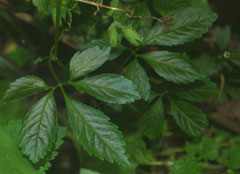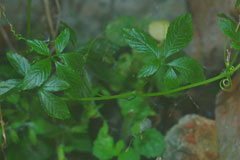 |
|
http://commons.wikimedia.org/wiki/User:Doronenko |
 |
|
Translate this page:
Summary
Physical Characteristics

 Gynostemma pentaphyllum is a ANNUAL/PERENNIAL growing to 8 m (26ft 3in).
Gynostemma pentaphyllum is a ANNUAL/PERENNIAL growing to 8 m (26ft 3in).
See above for USDA hardiness. It is hardy to UK zone 8. It is in leaf from May to October, in flower from July to August. The species is dioecious (individual flowers are either male or female, but only one sex is to be found on any one plant so both male and female plants must be grown if seed is required). and is pollinated by Insects. The plant is not self-fertile.
Suitable for: light (sandy), medium (loamy) and heavy (clay) soils and prefers well-drained soil. Suitable pH: mildly acid, neutral and basic (mildly alkaline) soils. It cannot grow in the shade. It prefers moist soil.
UK Hardiness Map
US Hardiness Map
Synonyms
Plant Habitats
Cultivated Beds;
Edible Uses
Edible Parts: Leaves
Edible Uses: Tea
Leaves and young stems - cooked[105, 177, 183]. The leaves have a sweet taste and are used as a tea[105, 177, 183].
References More on Edible Uses
Medicinal Uses
Plants For A Future can not take any responsibility for any adverse effects from the use of plants. Always seek advice from a professional before using a plant medicinally.
Alterative Anticholesterolemic Antispasmodic Hepatic Hypoglycaemic Sedative Tonic
The whole plant is a tonic herb that improves the circulation, stimulates liver function, strengthens the immune and nervous systems, and reduces blood sugar and cholesterol levels[238]. It also has sedative effects, relieving spasms and lowering the blood pressure[238]. It is used internally in the treatment of nervous tension and exhaustion, peptic ulcer, asthma, bronchitis, diabetes, cardiovascular disease and cancer[238]. It was rated among the ten most important tonic herbs at a conference on traditional medicines in Beijing in 1991[238].
References More on Medicinal Uses
The Bookshop: Edible Plant Books
Our Latest books on Perennial Plants For Food Forests and Permaculture Gardens in paperback or digital formats.

Edible Tropical Plants
Food Forest Plants for Hotter Conditions: 250+ Plants For Tropical Food Forests & Permaculture Gardens.
More

Edible Temperate Plants
Plants for Your Food Forest: 500 Plants for Temperate Food Forests & Permaculture Gardens.
More

More Books
PFAF have eight books available in paperback and digital formats. Browse the shop for more information.
Shop Now
Other Uses
Cosmetic
The plant is used in proprietary preparations for cosmetics and anti-ageing tonics[238].
Special Uses
Food Forest
References More on Other Uses
Cultivation details
Requires a rich well-drained but moisture-retentive soil in a warm sheltered position in partial shade[238]. This species is not hardy in the colder areas of the country, it tolerates temperatures down to between -5 and -10°c[200]. A problematic crop outdoors in Britain, it can be grown successfully as an annual in a greenhouse but requires a long hot summer if it is to do well outdoors. Plants tend to be annuals or short-lived perennials[238]. A climbing plant, attaching itself to supports by means of tendrils[238]. Dioecious, male and female plants must be grown if seed is required. Some plants might be monoecious[200].
References Carbon Farming Information and Carbon Sequestration Information
Temperature Converter
Type a value in the Celsius field to convert the value to Fahrenheit:
Fahrenheit:
The PFAF Bookshop
Plants For A Future have a number of books available in paperback and digital form. Book titles include Edible Plants, Edible Perennials, Edible Trees,Edible Shrubs, Woodland Gardening, and Temperate Food Forest Plants. Our new book is Food Forest Plants For Hotter Conditions (Tropical and Sub-Tropical).
Shop Now
Plant Propagation
Pre-soak the seed for 24 hours in warm water and then sow it in spring in a rich compost in a greenhouse, placing 2 - 3 seeds per pot. Thin the seedlings to the strongest in each pot and grow the plants on fast. Plant them out after the last expected frosts and protect them with a frame or cloche until they are growing away well.
Other Names
If available other names are mentioned here
Native Range
TEMPERATE ASIA: China (east), Korea, Japan (Hokkaidô, Honshu, Kyushu, Ryukyu Islands, Shikoku), Taiwan TROPICAL ASIA: India, Sri Lanka, Laos, Myanmar, Thailand, Vietnam, Malaysia
Weed Potential
Right plant wrong place. We are currently updating this section.
Please note that a plant may be invasive in one area but may not in your area so it's worth checking.
Conservation Status
IUCN Red List of Threatened Plants Status :

Growth: S = slow M = medium F = fast. Soil: L = light (sandy) M = medium H = heavy (clay). pH: A = acid N = neutral B = basic (alkaline). Shade: F = full shade S = semi-shade N = no shade. Moisture: D = dry M = Moist We = wet Wa = water.
Now available:
Food Forest Plants for Mediterranean Conditions
350+ Perennial Plants For Mediterranean and Drier Food Forests and Permaculture Gardens.
[Paperback and eBook]
This is the third in Plants For A Future's series of plant guides for food forests tailored to
specific climate zones. Following volumes on temperate and tropical ecosystems, this book focuses
on species suited to Mediterranean conditions—regions with hot, dry summers and cool, wet winters,
often facing the added challenge of climate change.
Read More
Expert comment
Author
(Thunb.)Makino.
Botanical References
58200266
Links / References
For a list of references used on this page please go here
Readers comment